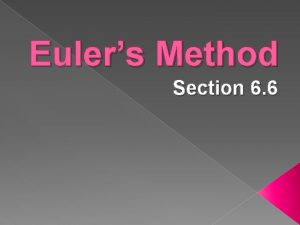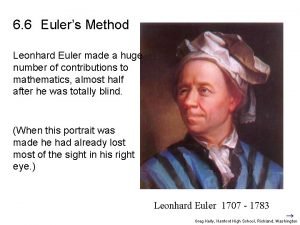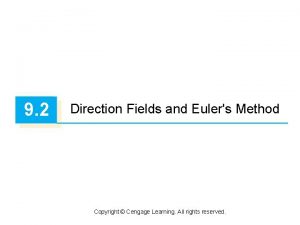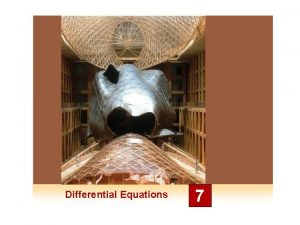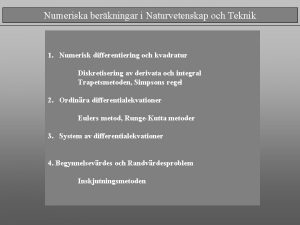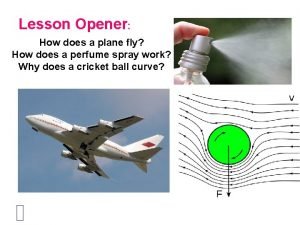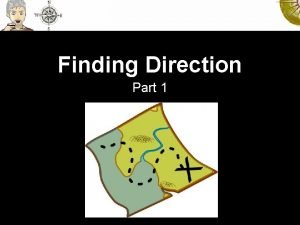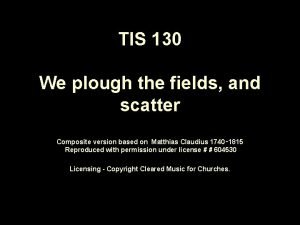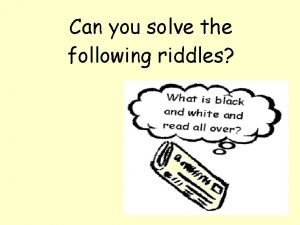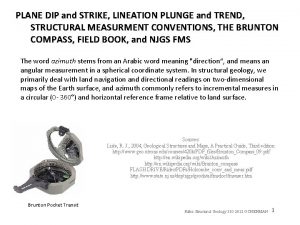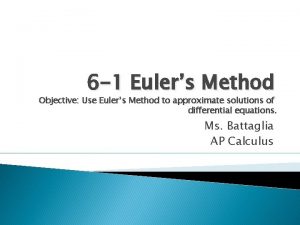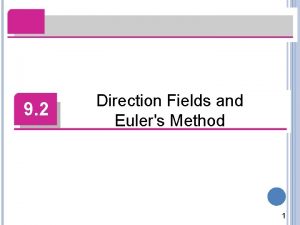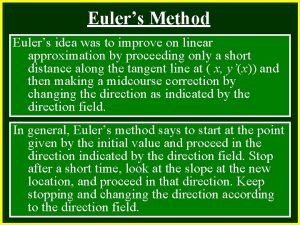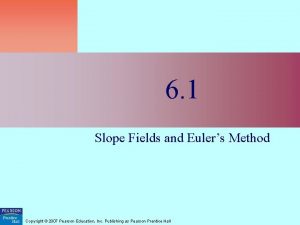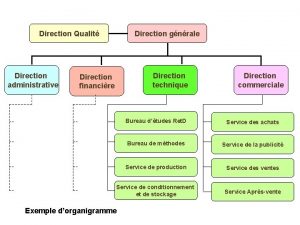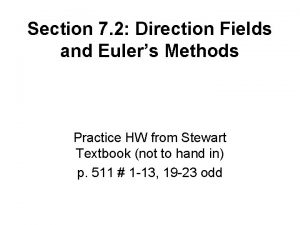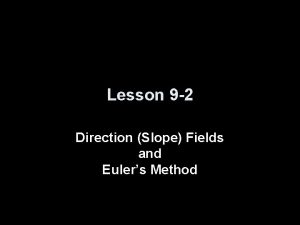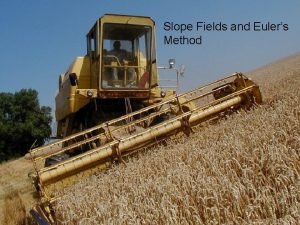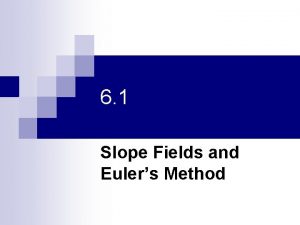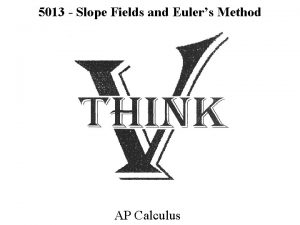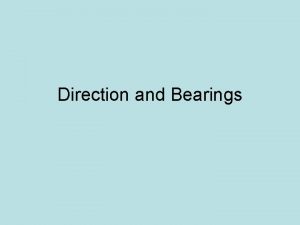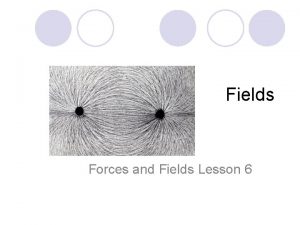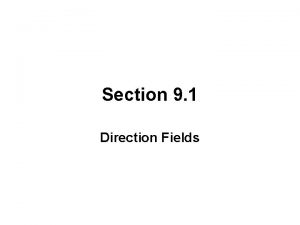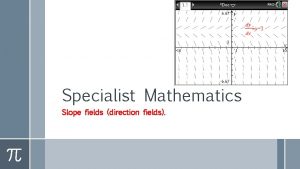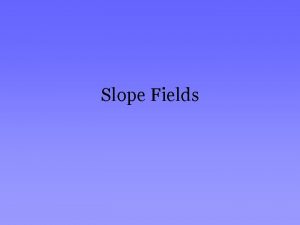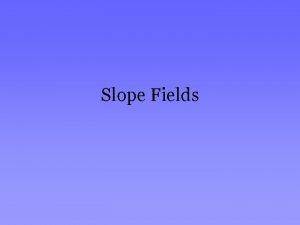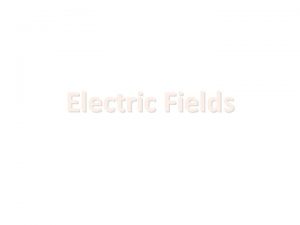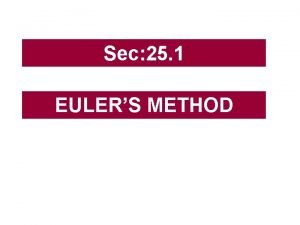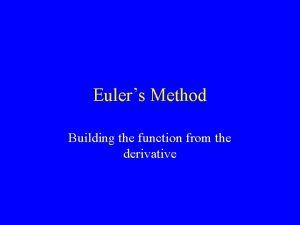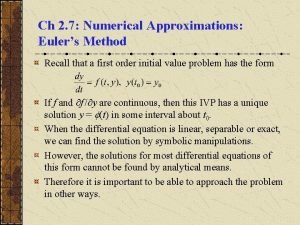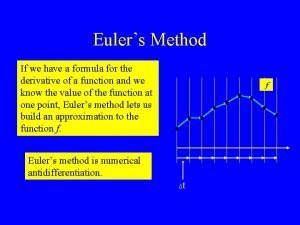9 2 Direction Fields and Eulers Method Copyright





























- Slides: 29

9. 2 Direction Fields and Euler's Method Copyright © Cengage Learning. All rights reserved.

Direction Fields and Euler's Method Unfortunately, it’s impossible to solve most differential equations in the sense of obtaining an explicit formula for the solution. In this section we show that we can still learn a lot about the solution through a graphical approach (direction fields /AKA: Slope Fields) or a numerical approach (Euler’s method). 2

Direction Fields Introduction by Khan Academy https: //www. youtube. com/watch? v=8 Amgakx 5 a. II https: //www. youtube. com/watch? v=hs. Tf. C 1 Wmxqc 3

Direction Fields Suppose we are asked to sketch the graph of the solution of the initial-value problem y = x + y y(0) = 1 We don’t know a formula for the solution, so how can we possibly sketch its graph? Let’s think about what the differential equation means. 4

Direction Fields The equation y = x + y tells us that the slope at any point (x, y) on the graph (called the solution curve) is equal to the sum of the x- and y-coordinates of the point (see Figure 1). A solution of y = x + y Figure 1 5

Direction Fields In particular, because the curve passes through the point (0, 1), its slope there must be 0 + 1 = 1. So a small portion of the solution curve near the point (0, 1) looks like a short line segment through (0, 1) with slope 1. Beginning of the solution curve through (0, 1) Figure 2 6

Direction Fields As a guide to sketching the rest of the curve, let’s draw short line segments at a number of points (x, y) with slope x + y. The result is called a direction field. Direction field for y = x + y Figure 3 7

Direction Fields For instance, the line segment at the point (1, 2) has slope 1 + 2 = 3. The direction field allows us to visualize the general shape of the solution curves by indicating the direction in which the curves proceed at each point. Now we can sketch the solution curve through the point (0, 1) by following the direction field. Notice that we have drawn the curve so that it is parallel to nearby line segments. The solution curve through (0, 1) Figure 4 8

Direction Fields If we draw short line segments with slope F (x, y) at several points (x, y), the result is called a direction field (or slope field). These line segments indicate the direction in which a solution curve is heading, so the direction field helps us visualize the general shape of these curves. 9

Example 1 (a) Sketch the direction field for the differential equation y = x 2 + y 2 – 1. (b) Use part (a) to sketch the solution curve that passes through the origin. Solution: (a) We start by computing the slope at several points in the following chart: 10

Example 1 – Solution cont’d Now we draw short line segments with these slopes at these points. The result is the direction field shown in Figure 5 11

Example 1 – Solution cont’d (b) We start at the origin and move to the right in the direction of the line segment (which has slope – 1). We continue to draw the solution curve so that it moves parallel to the nearby line segments. Returning to the origin, we draw the solution curve to the left as well. Figure 6 12

Classwork: Worksheet: Slopefields 13

Homework: Page 616 # 1 -12 all 14

Euler’s Method Khan Academy Introduction: https: //www. youtube. com/watch? v=q 87 L 9 R 9 v 274 Euler’s Method Formula by Calculus. Expert. com https: //www. youtube. com/watch? v=ypb 8 c. Kb. S 7 hk Watch all 3 videos 15

Euler’s Method The basic idea behind direction fields can be used to find numerical approximations to solutions of differential equations. We illustrate the method on the initial-value problem that we used to introduce direction fields: y = x + y y(0) =1 The differential equation tells us that y (0) = 0 + 1 = 1, so the solution curve has slope 1 at the point (0, 1). As a first approximation to the solution we could use the linear approximation L(x) = x + 1. 16

Euler’s Method In other words, we could use the tangent line at (0, 1) as a rough approximation to the solution curve (see Figure 12). Euler’s idea was to improve on this approximation by proceeding only a short distance along this tangent line and then making a midcourse correction by changing direction as indicated by the direction field. First Euler approximation Figure 12 17

Euler’s Method Figure 13 shows what happens if we start out along the tangent line but stop when x = 0. 5. (This horizontal distance traveled is called the step size. ) Since L(0. 5) = 1. 5, we have y(0. 5) 1. 5 and we take (0. 5, 1. 5) as the starting point for a new line segment. Euler approximation with step size 0. 5 Figure 13 18

Euler’s Method The differential equation tells us that y (0. 5) = 0. 5 + 1. 5 = 2, so we use the linear function y = 1. 5 + 2(x – 0. 5) = 2 x + 0. 5 as an approximation to the solution for x > 0. 5 (the green segment in Figure 13). If we decrease the step size from 0. 5 to 0. 25, we get the better Euler approximation shown in Figure 14. Euler approximation with step size 0. 25 Figure 14 19

Euler’s Method Euler’s method says to start at the point given by the initial value and proceed in the direction indicated by the direction field. Stop after a short time, look at the slope at the new location, and proceed in that direction. Keep stopping and changing direction according to the direction field. Euler’s method does not produce the exact solution to an initial-value problem—it gives approximations. 20

Euler’s Method But by decreasing the step size (and therefore increasing the number of midcourse corrections), we obtain successively better approximations to the exact solution. (Compare Figures 12, 13, and 14. ) Figure 12 Figure 13 Figure 14 For the general first-order initial-value problem y = F (x, y), y(x 0) = y 0, our aim is to find approximate values for the solution at equally spaced numbers x 0, x 1 = x 0 + h, x 2 = x 1 + h, …, where h is the step size. 21

Euler’s Method The differential equation tells us that the slope at (x 0, y 0) is y = F (x 0, y 0), so Figure 15 shows that the approximate value of the solution when x = x 1 is y 1 = y 0 + h. F (x 0, y 0) Similarly, y 2 = y 1 + h. F (x 1, y 1) In general, Figure 15 yn = yn – 1 + h. F (xn – 1, yn – 1) 22

Euler’s Method Video Introduction https: //www. youtube. com/watch? v=q 87 L 9 R 9 v 274 23

Example 3 Use Euler’s method with step size 0. 1 to construct a table of approximate values for the solution of the initial-value problem y = x + y y(0) = 1 Solution: We are given that h = 0. 1, x 0 = 0, y 0 = 1, and F (x, y) = x + y. So we have y 1 = y 0 + h. F(x 0, y 0) = 1 + 0. 1(0 + 1) = 1. 1 y 2 = y 1 + h. F(x 1, y 1) = 1. 1 + 0. 1(0. 1 + 1. 1) = 1. 22 y 3 = y 2 + h. F(x 2, y 2) = 1. 22 + 0. 1(0. 2 + 1. 22) = 1. 362 This means that if y(x) is the exact solution, then y(0. 3) 1. 362. 24

Example 3 – Solution cont’d Proceeding with similar calculations, we get the values in the table: 25

Euler’s Method For a more accurate table of values in Example 3 we could decrease the step size. But for a large number of small steps the amount of computation is considerable and so we need to program a calculator or computer to carry out these calculations. 26

Euler’s Method The following table shows the results of applying Euler’s method with decreasing step size to the initial-value problem of Example 3. Notice that the Euler estimates in the table seem to be approaching limits, namely, the true values of y(0. 5) and y(1). 27

Euler’s Method Figure 16 shows graphs of the Euler approximations with step sizes 0. 5, 0. 25, 0. 1, 0. 05, 0. 02, 0. 01, and 0. 005. They are approaching the exact solution curve as the step size h approaches 0. Euler approximations approaching the exact solution Figure 16 28

Homework: Page 616 (Slope Fields) 1 -12 all Page 617 (Euler’s Method) 21, 22, 23 29
 Euler's method
Euler's method Euler's method formula
Euler's method formula Eulers method khan academy
Eulers method khan academy Eulers method
Eulers method Eulers method
Eulers method Red fields to green fields
Red fields to green fields Eulers stegmetod
Eulers stegmetod Eulers andra lag
Eulers andra lag Bernoulli's principle perfume spray
Bernoulli's principle perfume spray Euler's formula in fluid mechanics
Euler's formula in fluid mechanics Virtual fields method
Virtual fields method Virtual fields method
Virtual fields method Purpose of symposium
Purpose of symposium Shadow stick method finding direction
Shadow stick method finding direction Electric forces and fields concept review
Electric forces and fields concept review We plow the fields and scatter
We plow the fields and scatter New consultant training
New consultant training Learning: module 26: magnetic forces and fields
Learning: module 26: magnetic forces and fields Scrap heap magnet diagram
Scrap heap magnet diagram Chapter 16: electric forces and fields answers
Chapter 16: electric forces and fields answers I run over fields and woods all day
I run over fields and woods all day Equation of continuity in electromagnetism
Equation of continuity in electromagnetism Areas in psychology
Areas in psychology Chapter 33 conceptual physics
Chapter 33 conceptual physics Multiplicative inverse
Multiplicative inverse Electric currents and magnetic fields
Electric currents and magnetic fields Electric currents and magnetic fields
Electric currents and magnetic fields Demerits of bilingual method
Demerits of bilingual method Plunge and trend geology
Plunge and trend geology Norm rule fields
Norm rule fields
